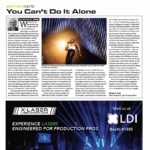The lighting crew is asking if I can hurry and focus, because there is lightning on the way and they wish to turn off power. I set up a console, clone some new lights called G-Spots (that I’ve never played with) and focus quickly. Then I watch idly as a monsoon engulfs the stage.
I’m peeved now. Not because it’s raining. Not because I have to turn off the lighting rig. I’m upset because after 30 years of programming moving lights, why do I still have to deal with weather disrupting my day? I’m serious. Which lights I spec on a show are not nearly as important to me as the fact they all work during the show. I swear, some lights just hate any humidity. My favorite strobes start flickering when there is a hint of rain. Why? It’s 2015.
Aren’t vendors tired of shipping power supplies overnight? I have personally raised the stock of FedEx because of rain. In 1999, I once had a tech named Rob Savage swap out 100 Studio Color power supplies in just one gig. That was 17 years ago. I guess I just expect more now.
So I start thinking about all the weather protection I’ve used and seen in my career. I used to build 40-foot-long tents of Visqueen to cover my front truss. That was great during the day, but at night I would still have to remove the tent to make the lights work properly. And then I would lose several power supplies to water, rendering the fixtures useless for at least that evening’s show. We covered chain motors with plastic bags. Cut holes in Tupperware allowing the clamps from a fixture to poke through, creating a shroud. These are tried and true helpful bits of prevention. But it’s 2015.
Some Progress
Lately I have seen snow protection tents made by Christie Lites that protected fixtures outside in the Canadian winter. I see great companies like Clay Paky and GLP make some neat protective domes for their fixtures. Upstaging has a “windshield”-type device that they strap to the yoke of a floor light. Carol Reed and her company, Custom Soft Goods make all kinds of cool gear for protecting motors and lights, etc.
As I said before, if a bright light has a couple of gobos and color mixing ability, I am happy to use it. So here I am in Mississippi playing for the first time with these SGM hard edge fixtures with LED light sources. I focused then programmed blind during the afternoon rain. It’s showtime, and I am seeing them work for the first time. They move great, have good colors, and they are doing what I programmed. It’s drizzling, and I notice a steady waterfall emitted from my upstage light truss. There are no worries. These lights are all waterproof. During the course of 90 minutes, I lose most of my strobes and a few PARs, but the movers keep working.
After the show, I’m chatting with the crew about the lights. I ask them how hard they are to fix. They don’t know. After six months, they still have not repaired one. They boast that you can pour water into the air vent and it will not harm the light, but I do not know that for a fact. What I do know is that if I was gonna invest a million bucks into buying a light rig, I would certainly think of what venues my lights would be predominantly in use. If it’s a state fair, a country back roads tour or any place by a mass of salt water, I wouldn’t hesitate to look into these fixtures.
A month after this gig, I find myself having dinner with Alex Gonzalez, the VP for Techni-Lux, a 24-year-old lighting company of high repute down in Orlando that distributes tons of stage gear, among them the SGM line. I asked him how much these lights cost, expecting a high figure. I was mistaken. I’m not going to quote any prices, but if you are like me and want all your lights to work regardless of the weather, you may want to reach out to Alex and his crew. Tell ‘em Nook sent ya. Find more info at techni-lux.com.
For Nook Schoenfeld’s introduction to the August 2015 issue of PLSN, go to www.plsn.me/201508ednote.


